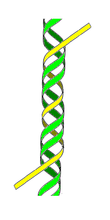RNA and DNA are both nucleic acids, but differ in three main ways. First, unlike DNA, which is, in general, double-stranded, RNA is a single-stranded molecule in many of its biological roles and has a much shorter chain of nucleotides. Second, while DNA contains deoxyribose, RNA contains ribose (in deoxyribose there is no hydroxyl group attached to the pentose ring in the 2' position). These hydroxyl groups make RNA less stable than DNA because it is more prone to hydrolysis. Third, the complementary base to adenine is not thymine, as it is in DNA, but rather uracil, which is an unmethylated form of thymine.
Like DNA, most biologically active RNAs, including mRNA, tRNA, rRNA, snRNAs, and other non-coding RNAs, contain self-complementary sequences that allow parts of the RNA to fold and pair with itself to form double helices. Structural analysis of these RNAs has revealed that they are highly structured. Unlike DNA, their structures do not consist of long double helices but rather collections of short helices packed together into structures akin to proteins. In this fashion, RNAs can achieve chemical catalysis, like enzymes. For instance, determination of the structure of the ribosome—an enzyme that catalyzes peptide bond formation—revealed that its active site is composed entirely of RNA
Sunday, April 3, 2011
Triple-stranded DNA

A triple-stranded DNA is a structure of DNA in which three oligonucleotides wind around each other and form a triple helix. In this structure, one strand binds to a B-form DNA double helix through Hoogsteen or reversed Hoogsteen hydrogen bonds.
For example, a nucleobase T binds to a Watson-Crick base-pairing of T-A by Hoogsteen hydrogen bonds between an AxT pair (x represents a Hoogsteen base pair). An N-3 protonated cytosine, represented as C+, can also form a base-triplet with a C-G pair through the Hoogsteen base-pairing of an GxC+. Thus, the triple-helical DNAs using these Hoogsteen pairings consist of two homopyrimidines and one homopurine, and the homopyrimidine third strand is parallel to the homopurine strand.
A homopurine third strand can also bind to a homopurine-homopyrimidine duplex using reversed Hoogsteen patterns. In this triplex, a nucleobase A binds to a T-A base pair and a G to a C-G pair. Since the nucleobases on the third strand have to be reversed, the homopurine third strand is antiparallel to the homopurine strand of the original duplex.
Triple-stranded DNA was a common hypothesis in the 1950s when scientists were struggling to discover DNA's true structural from. Watson and Crick (who later won the Nobel Prize for their double-helix model) originally considered a triple-helix model, as did Pauling and Corey who published a proposal for their triple-helix model in the 1953 scientific journal Nature, as well as fellow scientist Fraser. However, Watson and Crick soon identified several problems with these models: 1) Negatively charged phosphates near the axis will repel each other, leaving the question as to how the three-chain structure would stay together. 2) In a triple-helix model (specifically Pauling and Corey's model), some of the van der Waals distances appear to be too small. Fraser's model differed from Pauling and Corey's in that in his model the phosphates are on the outside and the bases are on the inside, linked together by hydrogen bonds. However, Watson and Crick found Fraser's model to be too ill-defined to comment specifically on its inadequacies in their publication in "Nature" (1953): Molecular Structure of Nucleic Acids.
Triple-stranded DNA was also described in 1957, when it was thought to occur in only one in vivo biological process: as an intermediate product during the action of the E. coli recombination enzyme RecA. Its role in that process is not understood.
Using nucleic acid segments that bind to the DNA duplexes to form triple strands as a way of regulating gene expression is under investigation by biotechnology companies. Similar work is also being undertaken at Yale University.
Subscribe to:
Posts (Atom)